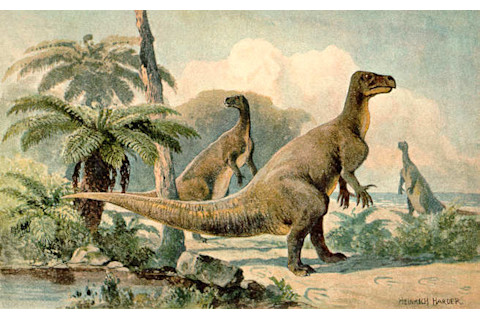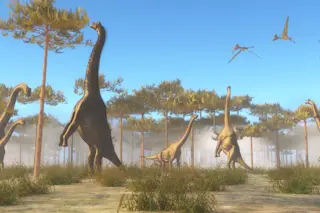What did dinosaurs eat? Some dinosaurs feasted on smaller lizards, eggs or even early mammals. Others hunted other dinosaurs as prey, or scavenged the remains of dead animals. Most dinosaurs, though, ate plants.
Research suggests more than 180 dinosaurs preferred a plant-based diet, but it’s quite hard to put a precise number on it, says Paul Barrett, a paleontology researcher at the Natural History Museum in London.
“There's a little bit of a gray area because some of the dinosaurs that we think mainly ate plants might have actually been omnivores,” Barrett adds.
Plant-Eating Dinosaurs
Most plant-eating dinosaurs belong to two categories: There were ornithischian — which means "bird-hipped" — dinosaurs, like Triceratops, Stegosaurus, Iguanodons and ankylosaurs, and sauropodomorph dinosaurs, which included long-necked dinos like Diplodocus, Brachiosaurus and Brontosaurus.
Several theropod dinosaurs — like the horse-sized Chilesaurus — seem to have given up meat for the diet of plants, but this evolutionary development didn't happen as often.
“The interesting thing about plant-eating is we think it has at least three (and possibly many more) independent origins in dinosaurs,” Barrett says. “We think the first dinosaurs were either carnivores or mixed feeders, so the ability to eat a purely vegetarian diet was something that appeared independently in each of those groups on several occasions.”
Read More: Scientists Unearthed a Meat-Eating Dinosaur in Argentina Named 'One Who Causes Fear'
Which Dinosaurs Ate Plants?
Researchers have known that plenty of dinosaurs have a penchant for plants for quite some time. “Historically, the understanding that many dinosaurs ate plants is older than the term dinosaur itself,” says David Button, a dinosaur researcher at the University of Bristol.

A historical depiction of a herd of Igaunodons by German artist Heinrich Harder. Early reconstructions of the dinosaur showed it upright in a kangaroo-like stance, although more recent studies suggest it walked on all fours. (Credit: The Wonderful Paleo Art of Heinrich Harder/Public Domain)
The Wonderful Paleo Art of Heinrich Harder/Public Domain
After its discovery in 1822, the Iguanadon, one of the first dinosaurs to be formally described, was named after its teeth, shaped like those of living iguanas. Since iguanas are herbivorous, this first finding illuminated the path for interpreting other dinosaurs as plant-eating.
“Essentially, do their teeth look like those of living herbivorous reptiles, primarily iguanas?” says Button.
Dinosaur Teeth Reveal What They Ate
Even today, teeth shape is still one of the main indicators of dino food preferences. Carnivorous dinosaurs have pointed teeth for piercing hide, for example, as well as perpendicular serrations like a steak knife to cut meat fibers.
Herbivorous dinosaurs, meanwhile, had different teeth shapes for shredding apart plant fibers: The animals tended to have oblique, large serrations to hold plants in place and help cut them, as well as flat, grinding surfaces — like horse teeth — and large numbers of teeth to mush up and chew plants. Since plant material is so much harder to digest than meat, it was crucial for herbivores to have a variety of mechanisms to effectively break down their food.
Read More: Tyrannosaurus Teeth Were Hidden Behind Lizard-Like Lips
Now, thanks to emerging technology, scientists identify more specific details about dino diets than before. By looking at the microscopic wear on the teeth, scholars can pinpoint what types of plants dinosaurs ate, according to Barrett.
They can also zoom in on the height at which those animals were feeding by observing scratches on their teeth — which can indicate the amount of grit a dinosaur ingested along with plants, revealing whether they were eating closer to ground level or toward the tops of trees, for example.
“But it's actually very difficult to get into the specifics of which species of plants particular dinosaurs were eating,” Barrett says.
Peering Into A Dinosaur’s Stomach
There are other methods for learning about dinosaur diets. We can glean all sorts of eating behaviors from preserved gut contents. Back in the late 18th and early 19th centuries, well-preserved, mummified duck-billed hadrosaur dinosaur remains were discovered in Canada — and researchers discovered pine needles and other vegetable material in carcass’s guts.
These specific findings were later upended, as the vegetation found in the dinosaur's stomach turned out to be debris that washed into the body cavity after death. But those initial observations nonetheless showed that scientists can examine the preserved gut contents from dinosaur remains to assess what they ate.
Read More: Armored Dinosaur’s Last Meal Found Preserved in Its Fossilized Belly

An illustration of Borealopelta chowing down on some ferns. (Credit: Julius Csotonyi/Royal Tyrrell Museum of Paleontology)
Julius Csotonyi/Royal Tyrrell Museum of Paleontology
In 2020, for instance, gut contents retrieved from an armored dinosaur Borealpeltar had charcoal in them, which shows that the animal was venturing into burned areas to munch on emerging vegetation in the wake of wildfires, Button says.
The Features Of Herbivore Dinosaurs
In addition to their teeth, the presence of a beak usually indicates that a dinosaur had a herbivorous diet. But beyond that, Button’s research specializes in learning about dinosaur jaw muscle mechanics to understand whether they preferred meat or plants, as well as differences in how they ate various types of plant material.
“What you tend to see, in carnivorous animals, is less efficient [jaw closure], but just bigger overall muscle power,” says Button. “Whereas in many plant-eating animals, depending on what they’re doing, closure is efficient, speed is no longer important, and that kind of thing.”
Read More: Here’s What Dinosaurs Really Looked Like
What's more, there were certain herbivorous dinos who, like birds, used a gizzard — a muscular second stomach for grinding down food — along with stomach stones to crunch up vegetation instead of chewing it in their mouths.
“Finding a cluster of these little stones together in the middle of the dinosaur’s ribcage is fairly good evidence that it might have had one of these gizzards, but we only find them in a handful of dinosaurs,” says Barrett.
The Case For Gigantic Guts
On the other hand, not all plant-eating dinosaurs like to chew their food. Those herbivores don’t need chewing teeth or very efficiently-closing jaws — preferring to gulp down their veggies in bigger portions and then digest them in the gut. This is an alternative strategy that we see in some living animals, such as tortoises, to an extent.
That's why scientists can also look at the size of a dinosaur's gut to understand whether it ate plants or not.
Sauropod dinosaurs, for example, evolved to have a long neck with a small lightweight skull on the end, so they couldn’t then evolve a battery of chewing teeth, which would have been too heavy on their long necks.

Titanosaurs like Argentinosaurus roamed the world around 66 million to 145 million years ago. (Credit: David Roland/Shutterstock)
David Roland/Shutterstock
As a result, some scientists speculate that they needed super-sized stomachs in order to swallow high-energy foods whole. Bigger guts also tend to be a better fit for larger animals, which is one of the reasons why so many herbivorous dinosaurs were also the biggest in general.
Different Ways Of Eating Plants Made Living Together Easier
Clearly, not all dinosaurs were created equal. And not only are the different features of herbivorous dinosaurs distinct from what scholars see in carnivorous dinosaurs, says Button, but they also remind us of the breadth of diverse ways to exist as a plant-eating dinosaur. This, in turn, helps us learn a little more about how these gigantic creatures could co-exist.
That diversity also helps support more diverse communities, akin to what we see in modern ecosystems where plant-eating animals (even if their diets overlap) specialize to feed in different ways, on different parts of the same plants or on different plants entirely.
“This unpicks the mechanisms that support diverse communities through evolutionary time,” says Button. “Also showing that some of the same ecological forces were patterning animal communities in the Mesozoic as today.”
Herbivore Dinosaurs and the Ecosystem
Regardless of whether we're talking about herbivores today or in the Age of Dinosaurs, most animals tend to eat plants. So if we don't understand what the plant-eaters are doing, says Barrett, we're missing a major part of that equation.
“If you want an understanding of how any ecosystem works, you really need to know what the herbivores are doing,” says Barrett.
But, paradoxically, plant-eating is also the more-difficult path from an evolutionary standpoint. Although it's hard to catch animals to eat them, that's the hardest part about being a carnivore.
Once you’ve caught your prey, that meal is likely high in nutrients and you don't need to eat as much. Plants, on the other hand, are very abundant, but you need to eat a lot more of them. Beyond that, plants are also chemically and physically harder to digest.
“It's actually the evolutionarily harder thing to be able to do,” says Barrett. “So understanding why animals should have done that so many times is actually an interesting question.”
Plant-Eating Dinosaurs Teach Us About Evolution
Dinosaurs can provide researchers with a fascinating glimpse into the inner workings of evolution for several reasons: they're quite well understood; they lived for such a long period of time; and they inhabited drastically different environments.
“I'm not going to necessarily pretend that results that we get from dinosaurs are directly relevant to understanding how things will change in the future,” says Button. “But still, they’re helping to derive evolutionary patterns, or even ideal evolutionary rules that will help us to understand how ecosystems react with future changes.”
Read More: These 7 New Dinosaur Species Were Unearthed In 2022















